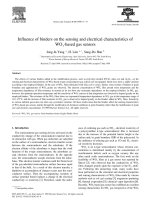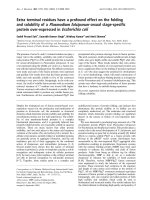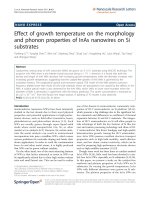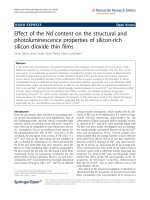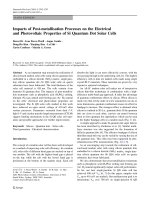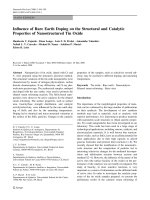Temperature effect on the thermal and hydraulic conductivity of Korean bentonite buffer material
Bạn đang xem bản rút gọn của tài liệu. Xem và tải ngay bản đầy đủ của tài liệu tại đây (3.94 MB, 8 trang )
Progress in Nuclear Energy 137 (2021) 103759
Contents lists available at ScienceDirect
Progress in Nuclear Energy
journal homepage: www.elsevier.com/locate/pnucene
Temperature effect on the thermal and hydraulic conductivity of Korean
bentonite buffer material
Seunghun Park a, 1, Seok Yoon b, *, 1, Sangki Kwon a, Min-Su Lee b, Geon-Young Kim b
a
b
Dept. of Energy Resources Engineering, Inha University, 100 Inha-ro, Michuhol-gu, Incheon, South Korea
Radioactive Waste Disposal Division, Korea Atomic Energy Research Institute, 111, Daedeok-daero 989, Beon-gil, Yuseong-gu, Daejeon, South Korea
A R T I C L E I N F O
A B S T R A C T
Keywords:
Gyeongju bentonite
Thermal conductivity
Hydraulic conductivity
Temperature effect
High-level radioactive waste (HLW) disposal is considered to constitute a disposal system within a deep rock
mass using deep geological repository. A deep geological disposal system has an engineered barrier system (EBS)
consisting of canisters, buffer material, and backfill material. Among these items, the buffer material protects a
canister from groundwater inflow and prevents radionuclide outflow. It is an also very important factor for
evaluating the stability of a disposal system in which heat is propagated from the canisters. The aim of this study
was to evaluate the thermal and hydraulic properties of Gyeongju bentonite, a buffer material from Korea. The
thermal conductivity and hydraulic conductivity of Gyeongju bentonite were measured according to different
degrees of saturation and to dry density. The whole process is based on the temperature change induced in the
disposal environment. The thermal conductivity increased as temperature increased, and as did the temperature
effect with high initial degree of saturation. Additionally, the hydraulic conductivity also increased as temper
ature did, and decreased with high dry density. After the process of heating and cooling, the thermal and hy
draulic conductivity of the bentonite presented irreversible changes.
1. Introduction
A geological repository for high-level radioactive waste (HLW) is an
underground facility for which stable management is essential. This
management includes consideration of risk factors such as leakage of
radioactive nuclides and high heat emission from the spent fuel. The
deep geological disposal with an engineered barrier system (EBS) is
recommended to dispose HLW (Kim et al., 2011; Kwon et al., 2013). The
components of an EBS include canisters, backfill, buffers, and the
near-field rock (Fig. 1). The buffer is an important component and can be
utilized for the reduction of groundwater inflow from the near-field
rock. It is both for blockage of leaks of radioactive nuclides dissolved
in groundwater from the spent fuel and for protection of the canister
from physical shocks such as rock shear behavior. The materials used in
designing the buffer were evaluated and bentonite was found to be most
suitable. It has been chosen in many studies related to the characteristics
of candidate buffer materials (Lee et al., 2011, 2017). Bentonite has the
characteristics of low permeability and high radionuclide retention ca
pacity. However, these properties might be deteriorated with increasing
temperature due to the decay heat from the spent fuel. Therefore, it is
important to understand the thermal and hydraulic characteristics of the
bentonite. They are considered to be affected by decay heat generated by
the spent fuel.
The EBS in the disposal environment is necessary to dissipate heat
generated by spent fuel in the canisters and to prevent the release of
nuclides due to inflow of groundwater from the surrounding rock. Above
all, the buffer plays an important role in ensuring that the heat in the
disposal environment leads to damage to canisters and change in the
rock behavior, on account of excessive thermal stress and thermal
expansion respectively. Many countries have limited the maximum
value of allowable temperature of the buffer to less than 100 ◦ C (Choi
et al., 2008; Lee et al., 2007; Lee et al., 2014; JNC, 1999). For this reason,
much research has been done on change in the characteristics of
bentonite due to exposure to high temperature in a repository where
long-term performance of the system is critical. The researches on
bentonite indicate that temperature change has an luence on its hy
draulic and thermal characteristics (Daniels et al., 2017; Ye et al., 2013,
Yoon et al., 2018; Zihms and Harrington, 2015). The hydraulic con
ductivity of bentonite is known to increase as temperature increases
(Cho et al., 1999).The reasons for change in hydraulic conductivity due
* Corresponding author.
E-mail address: (S. Yoon).
1
These authors contributed equally to this work.
/>Received 3 November 2019; Received in revised form 21 April 2021; Accepted 23 April 2021
Available online 4 May 2021
0149-1970/© 2021 The Authors. Published by Elsevier Ltd. This is an open access article under the CC BY license ( />
S. Park et al.
Progress in Nuclear Energy 137 (2021) 103759
This explains why the rise and fall of the buffer temperature in the re
pository environment will inevitably occur. This is also the reason the
buffer properties need to be considered from the viewpoint of long-term
integrity given the temperature change phenomena in a geological re
pository. Some evaluations of the buffer properties have been already
performed, considering the rise and the fall in temperature (Chen et al.,
2017; Daniels et al., 2017; Zihms and Harrington, 2015). In most of the
previous research, although Na-type bentonite was used to understand
the thermal and hydraulic behaviors of bentonite on the temperature
change, there has been little research on Ca-type bentonite in terms of
diversity of bentonite researches. Furthermore, there has been little
evaluation for the thermal and hydraulic properties of a buffer consid
ering various dry density and water evaporation under conditions in
which the temperature rises and falls.
In this study, an investigation of the thermal and hydraulic proper
ties of a buffer was conducted. Not only did it consider the rise and fall of
temperature, but it involved other variables such as the degree of
saturation and various dry density, which were not considered in pre
vious researches. In Korea, Gyeongju bentonite, which is Ca-type pro
duced from Gyeongju province, is regarded as a candidate for the buffer
material for Korean reference disposal system. Therefore, this research
aimed to help understand the thermal and hydraulic properties of this
Ca-type bentonite.
Fig. 1. Concept of the engineered barrier system in a deep disposal repository
(Yoon et al., 2019).
to increasing temperature can be explained as contributions from the
change of both water viscosity and density (Lide, 1995; Villar et al.,
2010). When the degree of saturation might decline, the thermal con
ductivity of bentonite is known to decrease with increasing temperature
(Yoon et al., 2018). It is thought that the temperature contributes to the
evaporation of water in the pores of bentonite (Cho, 2019). On the other
hand, the thermal conductivity of bentonite increases in some cases with
increasing temperature (Xu et al., 2019), which can vary depending on
the degree of saturation of bentonite and the sealing environment of the
experiment. In a disposal repository subject to environmental change in
temperature and groundwater inflow, research on the thermal and hy
draulic properties of bentonite is definitely critical in terms of long-term
integrity and sealing performance of the buffer.
The temperature of EBS is expected to change for a long period of
time with the heat emissions from the canisters. In addition, tempera
ture change is considered as a necessary factor for the repository system
management. Most of the researches studying the temperature effects on
bentonite have been carried out to evaluate the bentonite properties. In
the process, the condition only up to the maximum temperature created
by decay heat has been considered (Cho et al., 2017). In a geological
repository where change in the long-term behaviors occur, a tempera
ture decreases occurs after the maximum temperature is reached, as
shown in Fig. 2. Such phenomenon on the temperature change of the
buffer in a geological repository was predicted from computer modeling.
2. Materials and test methods
2.1. Characterization of Gyeongju bentonite
Bentonite composes of the minerals such as montmorillonite, quartz,
feldspar, halloysite, clinoptilorite, cristobalite, and a small amount of
organic matter. The bentonite mined in the Gyeongju area of South
Korea is called Gyeongju bentonite. Gyeongju bentonite is classified as a
Ca-type bentonite in which Ca cations occur between layers of mont
morillonite. The representative bentonite of the Na-type is MX-80,
which is mined in Wyoming (U.S.A). The main mineral content of MX80 includes montmorillonite (90%) and others (10%) such as cristoba
lite, feldspar, quartz, etc. (Zihms and Harrington, 2015). In contrast, the
main minerals in Gyeongju bentonite are montmorillonite (62%), feld
spar (21%), and small amounts of other minerals (~17% of such as
quartz (5%), cristobalite (4%), calcite (5%),heulandite (3%)). In Korea,
researches on physical, hydraulic, thermal, and chemical characteriza
tions were carried out to investigate the possibility that Gyeongju
bentonite can be used as a candidate for buffer material (Lee et al.,
2011). The typical characterizations of Gyeongju bentonite are pre
sented in Table 1.
2.2. Thermal conductivity test
Measurement of the thermal conductivity of bentonite was con
ducted using QTM-500. When it comes to measurement, QTM-500 has
the advantage that it can easily and rapidly obtain thermal conductivity
using the transient hot-wire method. The transient hot-wire method is a
calculation method using the relationship between the temperature of a
hot wire and the time needed for the flow of heat (thermal flow) to pass
through the specimen to reach the probe. The probe used for the thermal
Table 1
Various properties of Gyeongju bentonite (Yoo et al., 2015; Yoon et al., 2019).
Fig. 2. Temperature change of buffer material over time as predicted from
modeling (Lee et al., 2019).
2
Property
Gyeongju bentonite
Water content (%)
Swelling Index (mL/2g)
Particle density (g/cm3)
Porosity (%)
Specific surface area (m2/g)
Cation Exchange Capacity (meq/100g)
Plastic Index (%)
10.96
8
2.632
39.2
61.5
64.7
118.3
S. Park et al.
Progress in Nuclear Energy 137 (2021) 103759
conductivity measurement was PD-11, which was designed to make it
only possible for the heat to flow into specimen from the hot wire, as
shown in Fig. 3(a). The bentonite powder was compressed in accordance
with the dry density of 1.61 g/cm3, and the compacted specimen had the
dimensions 100 × 50 × 20 mm. The thermal conductivity was deter
mined using Eq. (1).
t2 / t1
λ = Kt × R × I × ln
− Ht
T2 − T1
2
1999; Daniels et al., 2017). The modified constant head test has the same
methodology as the other experiments do; the difference is whether the
constant pressure is supplied or not. According to Darcy’s law, the hy
draulic conductivity of fluid saturated bentonite can be calculated as
follows:
Kh =
(1)
Q
A × Hh
(2)
where Kh is the hydraulic conductivity (m/s), Q is the volumetric flow
rate (m3/s), A is the surface area of the specimen (m2), and Hh is the
hydraulic gradient (m/m).
Darcy’s law assumes that linearity may exist between the hydraulic
gradient and the flow rate. This linearity comes from the proportion in
the hydraulic gradient generated by the amount of fluid running through
a porous medium. For this reason, devices were required that could
provide a constant hydraulic gradient in order to measure the hydraulic
conductivity. In this study, a GDS Advanced Pressure/Volume Controller
(ADVDPC) was used to measure the hydraulic conductivity of the
bentonite. This device consisted of a gauge which can measure and
control the fluid pressure and change in volume. The fluid from this
device can be injected to water or oil, and an additional device is needed
to inject air. In this experiment, distilled water was used as the fluid. The
gauge was used in the pressure range 0.1–8 MPa, depending on the solid
volume. The specimen in the cell was maintained at a differential
pressure of 1.2–1.3 MPa of injection pressure and 0.2 MPa of back
pressure. The experimental setup measured the amount of water that
was penetrated and accumulated in the bentonite to provide a flow of
water from the top of the cell.
In order for the experiment to be conducted, compacted circular
blocks with diameter of 50 mm and height of 10 mm, were produced
using Gyeongju bentonite with about 11% of water content. The test
condition of hydraulic conductivity was maintained as measurement
where λ is the thermal conductivity (W/m∙K). Kt and Ht , the correction
factor on the measurement device were calculated from the data on the
reference samples which were quartz: 1.42 W/m∙K, silicon rubber: 0.24
W/m∙K, and plastic: 0.036 W/m∙K. R is the electric resistance of the
probe (Ω/m) per unit length, I is the heating current (A), t2 and t1 are the
time from the yield of electronic current (t1 = 30 s, t2 = 60 s), and T2 and
T1 are the temperatures (K) at t2 and t1 .The specimen and probe were
sealed with thermo tape to prevent water from escaping the specimen.
They were placed in a furnace during the experiment in order to control
the temperature variation, as shown in Fig. 3(a). The thermal conduc
tivity of the compacted bentonite at a certain temperature was measured
until the temperature became constant.
2.3. Hydraulic conductivity test
The hydraulic conductivity test for a soil material can be measured
by the constant head or failing head method. Both methods are suitable
for applications with highly permeable soil. If the constant head or
failing head test were used to measure the hydraulic conductivity of
bentonite, it would be possible to get erroneous results due to the lead
time of the experiment and the evaporation of water (Cho, 2019). Many
researchers have measured the hydraulic conductivity of bentonite
using the modified constant head test (Chen et al., 2017; Cho et al.,
Fig. 3. Setup for the measurement of thermal conductivity and hydraulic conductivity.
3
S. Park et al.
Progress in Nuclear Energy 137 (2021) 103759
concept of Fig. 3(b). Before the hydraulic conductivity test, the
bentonite was fully saturated by slowly supplying 0.1–1 MPa of water
pressure inside the cell from Day 1 to Day 10.
Table 3
Details of experimental process of the hydraulic conductivity test.
2.4. Conditions for tests of thermal and hydraulic conductivity
All experiments were conducted with respect to the expected tem
perature hysteresis of the buffer in the disposal repository. The tem
perature hysteresis means the variation of the temperature change in the
repository condition. It was reflected in the test procedure with
consideration of the research results of Cho et al. (2017). They have
predicted the long-term temperature change of the buffer. In this study,
the temperature hysteresis was related to the heating and cooling pro
cess, which means the temperature of the buffer material changes. Ac
cording to the previous researches, in a disposal repository, it is
inevitable that the temperature of the buffer increases and decreases.
For this reason, changes were observed in the thermal and hydraulic
properties of bentonite during heating and cooling process. It was to
investigate the reversibility of the bentonite properties after heating and
cooling.
The unsaturated bentonite specimens for the thermal conductivity
test were used with various degrees of water saturation. The heating and
cooling process (Test conditions: 2–6) was reflected, as listed in Table 2.
According to the test conditions regarding the degree of saturation, the
bentonite for the thermal conductivity was used in the heating and
cooling process for certain periods of time (4–10 h).
The compacted bentonite specimens with various dry densities from
1.3 to 1.74 g/cm3 were used for the hydraulic conductivity test and it
reflected the heating and cooling processes (Test conditions: 2–6) as
listed in Table 3. Under each test condition, the bentonite was allowed to
be heated and cooled for certain periods of time (0.5–1 day) to achieve
temperature equilibrium. During all of the cooling processes in the
thermal and hydraulic conductivity tests, the temperature of the
bentonite was decreased by natural cooling at a constant temperature.
Because the suggested dry density of compacted bentonite is more
than 1.6 g/cm3, compacted bentonite with a dry density of 1.61 g/cm3
was used to measure the thermal conductivity. The thermal conductivity
increases as the temperature increases, as shown in Fig. 4. The bentonite
is composed of three phases (i.e., soil particles, water, and air). The
thermal conductivities of soil particles, water, and air are proportional
to the temperature increase in the range 20–90 ◦ C (Cengel and Chajar,
2011). Thus, it is thought that thermal conductivity of compacted
bentonite would also increase with temperature increase. The higher the
compacted bentonite’s initial degree of saturation is, the higher the
thermal conductivity should increase with temperature. It was assumed
that degree of saturation was almost constant because it was impossible
to measure volume change during the experiment. Based on the previous
Table 2
Details of the experimental thermal conductivity test conditions.
Temperature
(◦ C)
Test
Duration
(hours)
Initial
Degree of
Saturation
Initial
Water
content
(%)
1.61
1 – No Heating
2 – Heating
3 – Heating
4 – Heating
5 - Cooling
6 - Cooling
25
43–45
61–63
83–86
55–60
25
4
7
10
4
4
0.21, 0.47,
0.61, 0.83
5.3, 11.9,
15.3 20.7
Temperature
(◦ C)
Test
Duration
(days)
Injection
Pressure
(MPa)
Back
Pressure
(MPa)
1.3, 1.4,
1.5, 1.6,
1.74
1 - Saturation
2 - Heating
3 - Heating
4 - Heating
5 - Cooling
6 - Cooling
25
30
60
90
60
30
1–10
1.5
1.5
1.5
2
2
0.1–1.0
1.2–1.3
–
0.2
research conducted by Xu et al. (2019), it was reported that the transfer
of latent heat had an impact on the thermal conductivity of soils. The
transfer of latent heat requires enough water and air movement for
water vapor to pass through during temperature increase. Furthermore,
the thermal conductivity was 1–6%, when cooling which was less than
heating. The soil’s particle size increased during heating and decreased
during cooling (Dong et al., 2019). From this, it is inferred that the
thermal conductivity of soils is related to the particle size during heating
and cooling. Moreover, the density of water decreases as temperature
increases (Cengel and Chajar, 2011), which, consequently, is likely that
it could not be recovered fully during the cooling process.
On account of heating and cooling, the variations show an irrevers
ible phenomenon: the decrease in the thermal conductivity with each
degree of saturation (Fig. 4). In addition, such phenomenon can be
explained by a change in the thermal behavior of particles and water,
from when soil is unsaturated. Ferrari and Laloui (2017) explained that
unsaturated soil subjected to cooling would generate an irreversible
volume change due to the rearrangement of the particles during their
thermal contraction. They also noted that heating and cooling of un
saturated soil would induce rearrangement of the particles and reduce
the volume of mass of water which is affected. Typically, when the
temperature drops, it is known that the thermal contraction coefficient
of water is 17 times greater than solids. The thermal contraction coef
ficient means the relative contraction rate of thermal strain between
water and solid after cooling (Sultan et al., 2002). It is believed that this
phenomenon contributes to the decrease of thermal conductivity due to
water. The water has higher thermal contractibility during cooling after
a temperature rise. During heating and cooling, the results of bentonite
properties change appeared to present a similar result in a previous
study related to irreversible phenomena (Sultan et al., 2002). The study
explained that irreversible phenomena led to the change in bentonite
properties due to the thermal behavior of bentonite (i.e. the change in its
properties) during heating and cooling.
3.1. Results for thermal conductivity
Test Condition
Test Condition
Fig. 4. Change in thermal conductivity of Gyeongju bentonite with saturation
and temperature.
3. Results
Density
(g/cm3)
Density
(g/cm3)
4
S. Park et al.
Progress in Nuclear Energy 137 (2021) 103759
3.2. Results for hydraulic conductivity
irreversible phenomenon is explained by the change of fully saturated
bentonite characteristics during the heating and cooling processes which
Punch (2015) introduced. Firstly, reduction of the swelling pressure of
bentonite was generated during the heating process. This would take
place when the particles were rearranged due to change in the bentonite
microstructure with the temperature increase. Then, the reduction of
swelling pressure would be expected to induce fluid penetration because
the binding force weakened between the particles. For this reason, it is
expected to influence the increase of hydraulic conductivity. Secondly,
the swelling pressure of the bentonite increased in the cooling process.
This is expected to be when the temperature drops, so that the filling of
the pores would occur due to contraction of the microchannels the
contraction was caused by the increase in swelling-pressure between the
rearranged particles. Therefore, it is thought hydraulic conductivity
during cooling reflects a slight decrease from the initial hydraulic con
ductivity during heating. As a result, irreversible change in the hydraulic
conductivity generated during heating and cooling seems to be due to
microstructural alteration by changes in the swelling pressure of the
bentonite.
The hydraulic conductivity of the bentonite with a given dry density
presents a non-linear change. It decreases hydraulic conductivity when
the dry density increases, as shown in Fig. 7. The tendency of the hy
draulic conductivity to decrease is reflected, at each dry density, by the
different effects of the swelling, which leads to decrease in the size of
pores between the particles of the compacted bentonite with increasing
dry density. In other words, the bentonite particles surface when they
come into contact with water. In addition, the combination of the
behavior of bentonite particles with water molecules presents pore
Hydraulic conductivity tests were conducted on compacted
bentonite samples of various densities. Tests considering the tempera
ture change at 30, 60, and 90 ◦ C measured the volume change over time
with water being injected. Fig. 5 shows change in the slope of the vol
ume dependent on time at a fixed injection pressure and back pressure.
The slope change was found to increase with temperature rise. In
addition, the correlation coefficient was close to 1.0 with the volume
change over time. The consequences of the inflow and outflow showed
that the slope change was similar to each other and that linearity was
shown in both of them.
As shown in Fig. 6, the hydraulic conductivity was found to change
with temperature increase (from 30 to 90 ◦ C) and decrease (from 90 to
30 ◦ C). An effect of temperature on bentonite which has various dry
densities tended to increase the hydraulic conductivity with heating. In
the heating process, temperature increase from 30 to 90 ◦ C resulted in
increase in hydraulic conductivity of about 0.2–2 times at each dry
density. The cause of this increase during heating might be due to the
change in water viscosity. Based on the previous study, water viscosity is
reported to be more sensitive to temperature increase. Moreover, water
viscosity is known to decrease when temperature rises in the range
below 100 ◦ C (Cho, 2019).
Hydraulic conductivity during cooling was observed to be lower than
during heating, as shown in Fig. 6. Table 4 represent the rate of change
in hydraulic conductivity during heating and cooling process. It is
believed that an irreversible phenomenon occurred due to change in the
bentonite microstructures during cooling after heating occurred. This
Fig. 5. Volume change of inflow and outflow at a fixed injection and back pressure.
5
S. Park et al.
Progress in Nuclear Energy 137 (2021) 103759
Fig. 6. Change in the hydraulic conductivity of Gyeongju bentonite with temperature.
each experimental temperature. Thus, the hydraulic behavior of the
buffer bentonite in a disposal environment is thought to generate a
change in the hydraulic conductivity property with temperature in
crease, and to follow a decrease in hydraulic conductivity if the buffer
material were used at high density.
Among the bentonite candidate materials, many studies have been
carried out using Ca- and Na-type bentonites. Zihams and Harrington
(2015) have drawn a conclusion that the permeability changes during
the heating and cooling process using Mx-80 (Na-type bentonite).
Similar to the results in this study (Ca-type bentonite) compared with a
previous study (Na-type bentonite), it was indicated that irreversible
phenomena of hydraulic properties generated with heating and cooling.
The intrinsic permeability was calculated using Eq. (3) to compare these
results with previous studies.
Table 4
Rate of change in hydraulic conductivity with the heating and cooling process.
Temperature change Change (%) in the hydraulic conductivity with different density
1.3 (g/cm3) 1.4 (g/cm3) 1.5 (g/cm3) 1.6 (g/cm3) 1.74 (g/cm3)
30 C
60 ◦ C
90 ◦ C
60 ◦ C
◦
-> 60 C
-> 90 ◦ C
-> 60 ◦ C
-> 30 ◦ C
◦
34%
48%
− 34%
− 36%
86%
68%
− 42%
− 48%
207%
458%
− 86%
− 62%
103%
51%
− 39%
− 50%
95%
78%
− 50%
− 45%
reduction. This is the reason water molecules in the hydrated layer of the
bentonite surface are strongly bound to the oxygen of the silicate surface
of the bentonite particles, so that the water cannot flow. An influence of
the hydraulic conductivity on the temperature with increasing dry
density is observed to have a difference of about 1–2 orders according to
k = Kh ×
6
ρw × g
μw
(3)
S. Park et al.
Progress in Nuclear Energy 137 (2021) 103759
Fig. 7. Change in the hydraulic conductivity of Gyeongju bentonite at various
dry densities.
Fig. 8. Intrinsic permeability change in Gyeongju and MX-80 bentonites.
(2) In the saturation hydraulic conductivity test, change of the hy
draulic gradient was clearly measured with increasing tempera
ture. The hydraulic conductivity increased linearly with
increasing temperature. The hydraulic conductivity increased at
an approximately up to 1 order in the heating process with each
change in dry density. In addition, all of the tests indicated an
irreversible change of hydraulic conductivity during cooling. The
hydraulic conductivity with increasing dry density presented a
tendency of non-linear decrease.
(3) Comparison of the intrinsic permeability of Gyeongju (Ca-type)
with MX-80 (Na-type) bentonites was performed during heating
and cooling processes. Both types of bentonite showed an irre
versible change in intrinsic permeability that decreased further
during cooling processes. In addition, the intrinsic permeability
of Ca-type and Na-type bentonite was about 1 order different, and
that of Ca-type was greater. Although the intrinsic permeability
of bentonite was confirmed, but these properties could be
affected by the intrinsic features of bentonite.
where k is the intrinsic permeability (m2), Kh is the hydraulic conduc
tivity (m/s), ρw is the water density (kg/m3), g is the acceleration of
gravity (m/s2), and μw is the water viscosity (Pa∙s, kg/m∙s).
The result of calculating the intrinsic permeability is shown in Fig. 8.
The MX-80 results were for dry density of 1.56 g/cm3 and Gyeongju
bentonite was for dry density of 1.6 g/cm3. There was a significant
difference in permeability change with the heating and cooling process,
and the permeability of Gyeongju bentonite was greater than of MX-80.
Moreover, Ca-type and Na-type bentonites present a difference of about
1 order of permeability. This is because the pore size is increased due to
the lower swelling effect of Ca-type bentonite, which is relatively less
than that of Na-type bentonite. Consequently, Ca-type bentonite is ex
pected to have greater permeability than Na-type is, and it is believed
that irreversible phenomena similarly occur with respect to the heating
and cooling process for both types of bentonite. Therefore, it is thought
that the swelling of bentonite has an influence on its permeability when
subject to heating and cooling processes, and that this is an intrinsic
feature of Ca- and Na-type bentonites. In the disposal environment, it is
necessary to take into account the effect of the change in permeability
generated by swelling as an intrinsic feature of bentonite which subject
to temperature changes.
For future studies, it is recommended that bentonite particle
behavior, bentonite mineral properties, and bentonite water behavior be
considered. It is for better understanding of the thermal and hydraulic
properties of the bentonite buffer material. In addition, the thermal and
hydraulic properties performed in this study may support analysis of the
buffer behavior using computer modeling of the disposal repository.
Furthermore, under the similar conditions to this study, future studies
are necessary to reflect the environmental factors in a disposal re
pository, including certain factors such as long-term behaviors, chemical
properties of the fluids, and constraints of the bentonite.
4. Conclusion
In this study, the thermal and hydraulic properties of Gyeongju
bentonite as buffer material were evaluated with regard to the tem
perature change due to the heat expected in a high-level radioactive
waste disposal site. Since the bentonite buffer materials are subjected to
rising and falling temperatures in a canister, it is important to identify
the thermal and hydraulic properties of bentonite with a consideration
of heat changes. There have been many previous studies on the evalu
ation for properties considering the effects of changes on Na-type
bentonite in the heat environment, while the study of Gyeongju
bentonite (Ca-type) was insufficient. Therefore, in this paper, thermal
conductivity and hydraulic conductivity, which are normally considered
as the most important on the thermal and hydraulic performance of
bentonite buffer materials, were measured for Gyeongju bentonite with
a consideration of the temperature changes. From this study, the
following conclusions were drawn:
Credit author statement
Seunghun Park: Investigation, Writing-review & editing. Seok
Yoon: Writing & editing, Supervision. Sangki Kwon: Editing. Min-Su
Lee: Investigation. Geon-Young Kim: Methodology.
Declaration of competing interest
The authors declare that they have no known competing financial
interests or personal relationships that could have appeared to influence
the work reported in this paper.
(1) In the thermal conductivity experiment considering the unsatu
rated state, the thermal conductivity increased linearly with
temperature rise. In the heating process, the thermal conductivity
increased up to about 0.1–0.2 W/m∙K with different degrees of
saturation. According to each degree of saturation, the thermal
conductivity during cooling was about 1–6% different in thermal
conductivity after heating process.
Acknowledgments
This research was supported by the Nuclear Research and Develop
ment Program of the National Research Foundation of Korea (NRF2021M2C9A1018633),
and
Basic
Research
Project
(NRF2020R1FA1072379) funded by the Minister of Science and ICT.
7
S. Park et al.
Progress in Nuclear Energy 137 (2021) 103759
Appendix A. Supplementary data
Lee, J.O., Cho, W.J., Kwon, S., 2011. Thermal-hydro-mechanical properties of reference
bentonite buffer for a Korean HLW repository. Korea Tunnel. Under. Spac. 21,
264–273.
Lee, J.O., Lee, M.S., Choi, H.J., Lee, J.Y., Kim, I.Y., 2014. Establishment of the Concept of
Buffer for an HLW Repository: an Approach. Korea Atomic Energy Research Institute
Report. KAERI/TR-5824.
Lee, J.O., Choi, H.J., Kim, G.Y., 2017. Numerical simulation studies on predicting the
peak temperature in the buffer of an HLW repository/Numerical simulation studies
on predicting the peak temperature in the buffer of an HLW repository. Int. J. Heat
Mass Tran. 115, 192–204.
Lee, C., Cho, W.J., Lee, J.W., Kim, G.Y., 2019. Numerical analysis of coupled thermoshydro-mechanical (THM) behavior at Korean Reference Disposal System (KRS) using
TOUGH2-MP/FLAC3D simulator. J. Nucl. Fuel. Cyc. Waste Techol. 17, 183–202.
Lide, R., 1995. Handbook of Chemistry and Physics, 75th edn. CRC press, New York.
Punch, R., 2015. Bentonite Clay : Environmental Properties and Applications. CRC press,
New York.
Sultan, N., Delage, P., Cui, Y.J., 2002. Temperature effects on the volume change
behavior of Boom clay. Eng. Geol. 64, 135–145.
Villar, M.V., Gomez-Espinal, R., Lloret, A., 2010. Experimental investigation into
temperature effect on hydro-mechanical behaviours of bentonite. J. Roc. Mech. Geo.
Eng. 2, 71–78.
Xu, Y., Sun, D., Zeng, Z., Lv, H., 2019. Temperature dependence of apparent thermal
conductivity of compacted bentonites as buffer material for high-level radioactive
waste repository. Appl. Clay Sci. 174, 10–14.
Ye, W.M., Wan, M., Chen, B., Chen, Y.G., 2013. Temperature effects on the swelling
pressure and saturated hydraulic conductivity of the compacted GMZ01 bentonite.
Environ. Earth Sci. 68, 281–288.
Yoo, M., Choi, H.J., Lee, M.S., Lee, S.Y., 2015. Chemical and Mineralogical
Characterization of Domestic Bentonite for a Buffer of an HLW Repository. Korea
Atomic Energy Research Institute Report. KAERI/TR-6182.
Yoon, S., Kim, M.J., Lee, S.R., Kim, G.Y., 2018. Thermal conductivity estimation of
compacted bentonite buffer materials for a high-level radioactive waste repository.
Nucl. Technol. 204, 213–226.
Yoon, S., Jeon, J.S., Kim, G.Y., Seong, J.H., Baik, M.H., 2019. Specific heat capacity
model for compacted bentonite buffer materials. Ann. Nucl. Energy 125, 18–25.
Zihms, S.G., Harrington, J.F., 2015. Thermal cycling: impact on bentonite permeability.
Mineral. Mag. 79, 1543–1550.
Supplementary data to this article can be found online at https://doi.
org/10.1016/j.pnucene.2021.103759.
References
Cengel, Y.A., Chajar, A.J., 2011. Heat and Mass Transfer: Fundamentals and Application,
fourth ed. McGraw Hill Education.
Chen, W.Z., Ma, Y.S., Yu, H.D., Li, F.F., Li, X.L., Sillen, X., 2017. Effects of temperature
and thermally-induced microstructure change on hydraulic conductivity of Boom
Clay. J. Roc. Mech. Geotech. Eng. 9, 383–395.
Cho, W.J., 2019. Bentonite Barrier Material for Radioactive Waste Disposal. Korea
Atomic Energy Research Institute Report. KAERI/GP-535.
Cho, W.J., Lee, J.O., Chun, K.S., 1999. The temperature effects on hydraulic conductivity
on compacted bentonite. Appl. Clay Sci. 14, 47–58.
Cho, W.J., Lee, C., Kim, G.Y., 2017. Feasibility analysis of the multilayer and
multicanister concepts for a geological spent fuel repository. Nucl. Sci. Technol. 200,
225–240.
Choi, H.J., Lee, J.Y., Kim, S.K., Kim, S.S., Kim, K.Y., Chung, J.T., Lee, M.S., Choi, J.W.,
Lee, J.O., 2008. Korean Reference HLW Disposal System. Korea Atomic Energy
Research Institute Report. KAERI/TR-3563.
Daniels, K.A., Harrington, J.F., Zihms, S.G., Wiseall, A.C., 2017. Bentonite permeability
at elevated temperature. Geosic 7 (3).
Dong, W., Pu, X., Ren, Y., Zhai, Y., Gao, F.X.W., 2019. Thermoresponsive bentonite for
water-based drilling fluids. Materials 12, 2115.
Ferrari, A., Laloui, L., 2017. Advances in Laboratory Testing and Modelling of Soils and
Shales (ATMSS). Springer series in geomechanics and geoengineering.
Jnc, 1999. H12 Project to Establish Technical Basis for HLW Disposal in Japan. Japan
Nuclear Cycle Development Institute. JNC/TN1400-99-020.
Kim, J.S., Kwon, S., Sanchez, M., Cho, G.C., 2011. Geological storage of high level
nuclear waste. KSCE J. Civ. Eng. 15, 721–737.
Kwon, S., Cho, W.J., Lee, J.O., 2013. An analysis of the thermal and mechanical behavior
of engineered barriers in a high-level radioactive waste repository. Nucl. Eng. Tech.
45, 41–52.
Lee, J.Y., Cho, D.K., Choi, H.J., Choi, J.W., 2007. Concept of a Korean reference disposal
system for spent fuels. J. Nucl. Sci. Technol. 44, 1563–1573.
8
